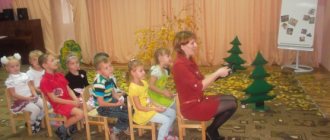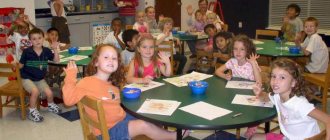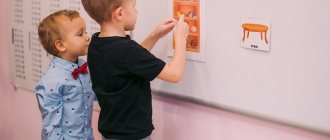Article:
Topic: Transport
Purpose: to generalize and systematize the idea of transport, to activate vocabulary on this topic, the practical use of prefixed verbs and compiling a short descriptive story using questions.
Program content:
Developmental task: Teach children to generalize, classify vehicles: cargo, passenger, fine motor skills, coordination of speech with movement, visual attention and perception.
Educational speech tasks: compose a descriptive story about this transport toy using questions:
- practice the practical use of words with affectionate and magnifying connotations;
- practical use of prefixed verbs;
- agree nouns with adjectives in number, gender, case;
- learn to compose a whole from parts (cut pictures).
Corrective task: to train children in the use of feminine and masculine nouns; expand your vocabulary on the topic “transport”.
Educational task: to teach children through game images the rules of behavior in public transport.
Materials: toys transport, pictures of transport, cut-out pictures of transport, audio recording “Bus”, panorama of the city with images of transport.
Progress of the lesson
— Guys, how did you get to kindergarten today, who lives far away, what? (On foot, car, bus)
- Those who live next to the kindergarten came on foot, those who live far from the kindergarten - went by bus, car, taxi (the teacher places the corresponding pictures on the magnetic board). What is a car, a bus, a taxi? (Transport)
— What are the people who travel in passenger transport called? (Passengers)
— What is the name of the machine that helps transport cargo? (Cargo)
— What kind of cargo can trucks transport (Furniture, sand, snow, food, gasoline, milk, etc.)
Pay attention to the panorama of the city, consider the image of transport. Finger game “Let’s count.”
We will bend our fingers - (clench and unclench our fingers) We will name transport: Car, taxi, Tram, metro, bus (unclench our fingers, starting with the little finger) We clenched 5 fingers into a fist, named 5 types of transport. (clench your fingers into a fist, starting with the thumb).
— Who drives passenger and cargo transport (driver, driver).
Generalization from the teacher: Cars are our helpers, but without a driver they cannot work. The driver must know well the structure of his car and its parts.
- Do you know what main parts it consists of?
— What is the name of that part of the car where the driver sits and controls the car? (Cabin)
—Where do they put the cargo? (Body)
— Where do the passengers sit? (Salon)
— Without which part will the car never move? (Without wheel)
Game exercise “Riding on the bus”
“Now let’s all take a ride on the bus together.” Who will we be on the bus? (Passengers). How should passengers behave on the bus and why?
I will speak, and you answer:
— The bus from the stop ( departed ), to another stop ( arrived ). Then he climbed a small hill ( drove in or drove over ) and together with us he bridged ( moved over ). He quickly entered the tunnel ( drove ) and from there soon to a gas station ( went, arrived ).
Speech game “At a gas station”
All the cars in order arrive at the gas station. (with both hands “turn the steering wheel” in front of you) A fuel truck, a garbage truck, a milk truck with milk, a grain truck with fresh bread, and a heavy timber truck.
(Fingers alternately, starting with the little finger, touch the palm).
Having refueled, the bus went to the exhibition-salon ( arrived, stopped ).
— An exhibition-salon of vehicles “Funny Motors” opened in our group. I will be the director, and you will be the car sales managers. You must tell us about the transport you like and advertise it:
Car name.
What is she like: describe her appearance, color.
Name the parts.
What is it intended for?
— I’ll start with advertising: This is a bus. He is red. It has a cabin, wheels, many windows, doors. The bus carries passengers.
Listen to 3-4 stories.
- Guys, in the distant fairy-tale country of “Liliput” there live little people and everything they have is small: clothes, shoes, and transport.
Game exercise “Big-small”
| Educator | Children |
| car | machine |
| automobile | car |
| truck | truck |
| tram | tram |
| trolleybus | trolleybus |
| bus | bus |
Cars are our faithful and reliable assistants. But in order for them to serve for a long time, they need to be looked after, repaired, and placed in the garage.
Didactic game “Fix the car”
The drivers pressed hard on the pedals, the car fell apart into parts. Help, help, assemble a car from parts.
Children assemble cars piece by piece (from cut-out pictures). At the end they say what they did.
And now I’m turning you into a machine, whoever wants what kind. And each of you will leave the lesson with your own signal. Verbal game “Pretend to honk your car’s horn” (honk your horn loudly for goodbye, honk quietly for the cars to drive far away).
Notes on speech development “Transport”
Subject:
Transport
Target:
generalize and systematize the idea of transport, activate vocabulary on this topic, the practical use of prefixed verbs and compiling a short descriptive story using questions.
Program content:
Developmental task:
Teach children to generalize and classify vehicles: cargo, passenger, fine motor skills, coordination of speech with movement, visual attention and perception.
Educational
speech tasks:
compose a descriptive story about this transport toy using questions:
- practice the practical use of words with affectionate and magnifying connotations;
- practical use of prefixed verbs;
- agree nouns with adjectives in number, gender, case;
- learn to compose a whole from parts (cut pictures).
Corrective task:
train children in the use of feminine and masculine nouns; expand your vocabulary on the topic “transport”.
Educational task:
teach children the rules of behavior in public transport through playful images.
Materials:
toys transport, pictures of transport, cut-out pictures of transport, audio recording “Bus”, panorama of the city with images of transport.
Progress of the lesson
— Guys, how did you get to kindergarten today, who lives far away, what? (On foot, car, bus)
- Those who live next to the kindergarten came on foot, those who live far from the kindergarten - went by bus, car, taxi (the teacher places the corresponding pictures on the magnetic board). What is a car, a bus, a taxi? (Transport)
— What are the people who travel in passenger transport called? (Passengers)
— What is the name of the machine that helps transport cargo? (Cargo)
— What kind of cargo can trucks transport (Furniture, sand, snow, food, gasoline, milk, etc.)
Pay attention to the panorama of the city, consider the image of transport. Finger game “Let’s count.”
We will bend our fingers - (clench and unclench our fingers) We will name transport: Car, taxi, Tram, metro, bus (unclench our fingers, starting with the little finger) We clenched 5 fingers into a fist, named 5 types of transport. (clench your fingers into a fist, starting with the thumb).
— Who drives passenger and cargo transport (driver, driver).
Generalization from the teacher: Cars are our helpers, but without a driver they cannot work. The driver must know well the structure of his car and its parts.
- Do you know what main parts it consists of?
— What is the name of that part of the car where the driver sits and controls the car? (Cabin)
—Where do they put the cargo? (Body)
— Where do the passengers sit? (Salon)
— Without which part will the car never move? (Without wheel)
Game exercise “Riding on the bus”
“Now let’s all take a ride on the bus together.” Who will we be on the bus? (Passengers). How should passengers behave on the bus and why?
I will speak, and you answer:
— The bus has left
), to another stop (
arrived
).
Then he climbed up a small hill ( drove in or drove over
) and together with us he bridged (
moved over
).
He quickly entered the tunnel ( drove
) and from there soon to a gas station (
went, arrived
).
Speech game “At a gas station”
All the cars in order arrive at the gas station. (with both hands “turn the steering wheel” in front of you) A fuel truck, a garbage truck, a milk truck with milk, a grain truck with fresh bread, and a heavy timber truck.
(Fingers alternately, starting with the little finger, touch the palm).
Having refueled, the bus to the exhibition-salon ( arrived, stopped
).
— An exhibition-salon of vehicles “Funny Motors” opened in our group. I will be the director, and you will be the car sales managers. You must tell us about the transport you like and advertise it:
Car name.
What is she like: describe her appearance, color.
Name the parts.
What is it intended for?
— I’ll start with advertising: This is a bus. He is red. It has a cabin, wheels, many windows, doors. The bus carries passengers.
Listen to 3-4 stories.
- Guys, in the distant fairy-tale country of “Liliput” there live little people and everything they have is small: clothes, shoes, and transport.
Game exercise “Big-small”
| Educator | Children |
| car | machine |
| automobile | car |
| truck | truck |
| tram | tram |
| trolleybus | trolleybus |
| bus | bus |
Cars are our faithful and reliable assistants. But in order for them to serve for a long time, they need to be looked after, repaired, and placed in the garage.
Didactic game “Fix the car”
The drivers pressed hard on the pedals, the car fell apart into parts. Help, help, assemble a car from parts.
Children assemble cars piece by piece (from cut-out pictures). At the end they say what they did.
And now I’m turning you into a machine, whoever wants what kind. And each of you will leave the lesson with your own signal. Verbal game “Pretend to honk your car’s horn” (honk your horn loudly for goodbye, honk quietly for the cars to drive far away).
Summary of a speech therapy lesson on the topic “Transport”
Summary of a speech therapy lesson in a preparatory group on teaching literacy and developing coherent speech
Topic: "Transport"
Goals:
- clarification and consolidation of knowledge on the lexical topic “Transport”.
- improving the practical use of qualitative adjectives.
- formation of word-formation skills based on exercises in the formation of relative adjectives; in the analysis of words of complex syllabic structure.
- development of coherent speech based on exercises in retelling texts with a cause-and-effect relationship and relying on subject pictures and questions.
- development of attention, memory, visual perception, logical thinking based on exercises in analysis, synthesis, classification, elimination.
Equipment: board, typesetting canvas, bibabo doll Kolobok, pictures-symbols of various types of transport, subject pictures depicting various types of transport, reference pictures for working on the retelling, red and blue hoops, teaching aid “Palette”.
Progress of the lesson:
1. Organizational point:
Standing in a circle, children join hands. Everyone says a few kind words to their neighbor, praises, supports, and reassures. Thank each other for understanding and support. Speech therapist: - Guys, I suggest you go on a journey through a fairy tale. Tell me, what can you use in a fairy tale: - to sail? (on a boat, on a ship...) - fly? (by plane, by helicopter, by hot air balloon...) - go? (by car, by bicycle, by train...) - how would you like to travel through the fairy tale? (children's answers, general choice).
2. Introduction to the topic of the lesson:
Speech therapist: - What can you call a train, a ship, a car? (transport) Name the transport that: - moves only on water (water); - moves only by air (airborne); - transports goods (cargo); -carries passengers (passenger); -moves only by rail (railroad)? Each child is offered a picture depicting one or another type of transport. Picture symbols are displayed on the board, indicating different types of transport (see equipment). Task: find the “house” in the picture.
3. Main part of the lesson:
Speech therapist: - So, today we will travel through a fairy tale, the main character of which is Kolobok. He hurries to tell us something: Kolobok (speech therapist): - One evening I was rolling along the path. Out of boredom I started counting the stars in the sky. Suddenly I see another Kolobok rolling across the sky. I didn’t recognize him and asked: “Who are you?” The heavenly Kolobok is silent. I wanted to get to know each other better, and the heavenly Kolobok came from me.
I’m swinging, I’m in a hurry, and a FIRE HORSE meets me. I began to ask the FIRE HORSE to help me catch up with the heavenly Kolobok, and the FIRE HORSE answered: “Fulfill my tasks, and I will help you.” Children help Kolobok tell what kind of HORSE IS FIRE (beautiful, kind, strong, swift, fire-maned, etc.). Children draw with markers on the board the path of the FIRE HORSE as he gallops quickly; thoughtfully; sad; fun, cheerful.
Kolobok: - I sat on the HORSE-FIRE, but we could not catch up with Kolobok in the sky. I sadly rolled on and then a CAR met me - a FAST TIRE. I asked her for help. CAR - FAST TIRE answers: “Help me, and I won’t be in debt!” Children, together with CAR - FAST TIRE: - correct the mistake in the word car, while reinforcing the rules for writing SHI, ZHI. — make up sentences with the word CAR according to given patterns (sentences of 2, 3, 4 words). - choose the correct sentence:
1) The car stopped because it ran out of gas. 2) The gas ran out because the car stopped. - answer the questions: a) Before getting on the train, I bought a ticket. What did I do first? b) After the traffic light turned green, the pedestrian crossed the street. What did the pedestrian do first?
When the CAR - FAST TIRE drives away, children are asked to remember which of the passengers was sitting first, last, behind the wheel of the car. Kolobok: - Unfortunately, the CAR - FAST TIRE could not help me either. I rolled further, and towards me was a STEAM LOGO - HUNDRED WHEELS. I also began to ask him for help. THE STEAM LOGO – A HUNDRED WHEELS answers: “If you help me, I’ll help you!” Children are asked to identify and name the parts of the locomotive. Then a subgroup of children receives parts of the locomotive and lays out (repairs) the locomotive on a flannelgraph from memory. The second subgroup of children completes the task of finding parts of a steam locomotive. /educational game “Palette”/
Everyone is invited to lay out the sound diagram of the word STEAM LOZO using hoops of the desired color. Kolobok: - I sat down on the STEAM LOGO, the wheels began to rattle, but again I couldn’t catch up with the other Kolobok... I rolled further along the sad path and suddenly I saw a PLANE in the sky - a FAST FLYER. I turned to him for help. PLANE - FAST FLIGHT replies: “Help me first!”
Helping Kolobok and FAST PLANE, the children explain what words make up the word PLANE, HELICOPTER, LUNOKHOD, SCOOTER. — I boarded a FAST PLANE and we flew off to catch up with the heavenly Kolobok. Only the Heavenly Kolobok is ahead again. Here the PLANE is a FAST FLYER and says: “I can’t catch up with him, maybe the ROCKET will help you?” I rolled towards the ROCKET, and she also prepared a task for me: “I’ll help you if you find and tell me what parts I’m made of!” -Children name the letters - the parts of the ROCKET, find them in the magnetic alphabet and make words from the letters. Kolobok: - A ROCKET took off... and then I noticed that the night was over, and the heavenly Kolobok had completely disappeared. That's the end of the fairy tale!
4. Consolidation of acquired knowledge.
Speech therapist: - Did you guess which Kolobok was rolling across the sky? Who helped our Kolobok catch up with the stranger? Children name all the heroes of the fairy tale, and corresponding pictures are displayed. Children retell a fairy tale. Children find the “extra” one among the pictures and explain their choice (all pictures show transport, and a horse is an animal).
5. Summary of the lesson.
Children remember which fairy tale they traveled through, who they met, who they helped and how. The speech therapist invites children to draw their favorite fairy tale characters at home.
Teacher-speech therapist of the State Budgetary Institution GPPC DogM: Tikhonova Elena Sergeevna
Also on topic:
Summary of a lesson on speech development on the topic “Transport”





